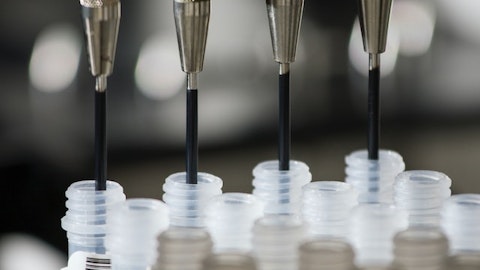So basically, our exon sequencing gives us many more potential mutation [indiscernible] compared to — relatively to smaller fixed panel target sequencing. So by using this data, let’s move to Page 14, basically, there are several major conclusion observation we have seen. So the Page 14 is showing actually — if you look at the preoperative plasma sample, so as you know, this sample is basically untreated patient coming from the — blood coming from untreated patients. And that’s why, ideally, if your assay is perfect, you should be able to see every patient blood will get like close to a very high percentage of detection sensitivity. As you can see here, the sensitivity definitely grow up from Stage 1 to Stage 3. And Stage 3, you’ve got the highest sensitivity — detection sensitivity.
But as you can see here the orange color, which is representing the PROPHET assay, so it outperformed the tumor-agnostic panel sequencing as well as our tumor-informed fixed panel sequencing. So totally, basically, at the Stage 2b, we already see 40% detectability, and also Stage 2, we see 75 patients with 83% positivity. And as you can see here in the panel B showing on the right page, as you can see here, for all three MRD-positive patient sample, the ctDNA [indiscernible] showing the highest one, which is shown in the box plot with the red background. But if only the — if you look at the orange color, which means on the right with 30 patient — preoperative patient only showing a positive in brPROPHET assay, but the ctDNA fraction is way lower, it’s actually two magnitude lower than the all three positive patients.
This just reflects the detection sensitivity importance, trying to get those kind of very low allele frequency, very low tumor fraction patient trying to confirm the MRD status. Of course, this is preoperative. So let’s move to the Page 15. Basically, we use a postoperative blood sample to determine the real MRD status and also come associated with this kind of a status with the relapse potential to look at the disease-free survival. On the left page, basically, as we are using the landmark time point, which is three days or — which is timepoint B of 30 days after surgery which is timepoint C to look at the survival curve. As you can see, the DFS survival percentage. If you’re MRD-negative, the patient showing that even for onetime point — landmark time point to check and follow-up up to like 1,200 days, this show very way higher disease-free survival compared to MRD-positive patient, which is showing the HR ratio reached to basically for timepoint C the HR other ratio reached to 16.4, which is a pretty significant difference.
And on the right page — right side of the panel, we’re basically utilizing longitude MRD and assets. This is basically for multiple point time point assessment on the post-surgery patient plasma sample. And if there’s an MRD-positive signal showing any time of the blood collection, we deem as MRD-positive. But if all the sample collected from patients is MRD-negative, then we deem it MRD-negative. As you can see here, the separation will be even better. That just gives us a lot of confidence also reflect a lot of other publications, continuous surveillance require multiple time point collection, usually give us better separation of the disease-free survival. So basically, it’s also not related to the Stage 1 or Stage 2 and 3, basically showing very similar trend.
So in summary, basically, this paper published in cancer cell gave us a very good example showing how the personalized [indiscernible] MRD assay can give a very good predates value on the non-small cell lung cancer, even Stage 1 and also 2 and 3. And so of course, we are still keep working on this assay and trying to working on multiple different kind of cancer type and also trying to — with other top-tier hospitals, not only prognosis value, we also want to look at the predictive value. And if you see any kind of clinical utility related to drug selection or any kind of treatment effectiveness assessment. So that concludes my part. Thank you. Back to moderator.
Operator: Thank you for participating in today’s call. You may now disconnect. Everyone, have a great day.
Yusheng Han: Thank you.
End of Q&A:
Follow Burning Rock Biotech Limited (NASDAQ:BNR)
Follow Burning Rock Biotech Limited (NASDAQ:BNR)
Receive real-time insider trading and news alerts




